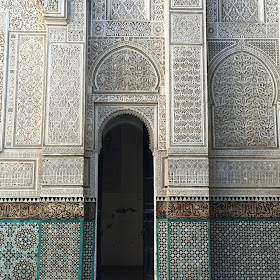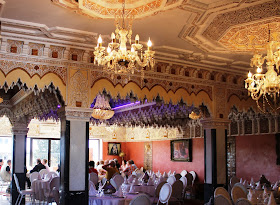When Bob told me he wanted to stay a few nights in a tent camp in the Sahara, I was not quite as excited about it as he was. He assured me that it would be nice, but "tent," "camp," "Sahara," and "nice" didn't go together in my mind.
After about eight hours on the road, our driver delivered us to the small village of Merzouga, located about 30 miles from the Algerian border and on the edge of a section of the Sahara known as Erg Chebbi. ("Erg" means "desert" or "dune.") We were met there by a man named Hassan, the young, energetic owner of Merzouga Bivouac Experience. We got into Hassan's four-wheel drive, and he headed straight into the dunes in a crazy Mr. Toad's Wild Ride style, bouncing and sliding all over the sand, then climbing steep grades and skidding down the other side. Bob loved it.
Hassan pointed out our tent camp in the distance but didn't stop:
Instead, he deposited us at the bottom of a tall dune and told us to climb to the top and wait for the sunset. A nice wind had kicked up, and anyone who wears contact lenses like I do understands that wind + Sahara Desert sand + contacts + no sunglasses = misery. I made it to the top, but I didn't stay long. I headed down the sand cliff far enough to miss the worst of the wind, but Bob stayed up on top:
After about eight hours on the road, our driver delivered us to the small village of Merzouga, located about 30 miles from the Algerian border and on the edge of a section of the Sahara known as Erg Chebbi. ("Erg" means "desert" or "dune.") We were met there by a man named Hassan, the young, energetic owner of Merzouga Bivouac Experience. We got into Hassan's four-wheel drive, and he headed straight into the dunes in a crazy Mr. Toad's Wild Ride style, bouncing and sliding all over the sand, then climbing steep grades and skidding down the other side. Bob loved it.
Hassan pointed out our tent camp in the distance but didn't stop:


















